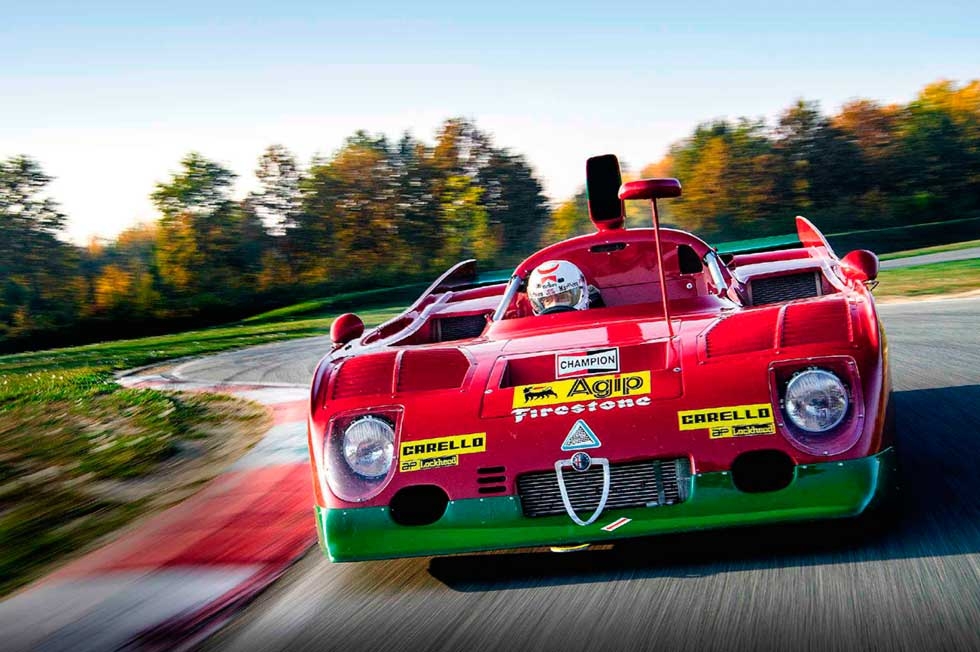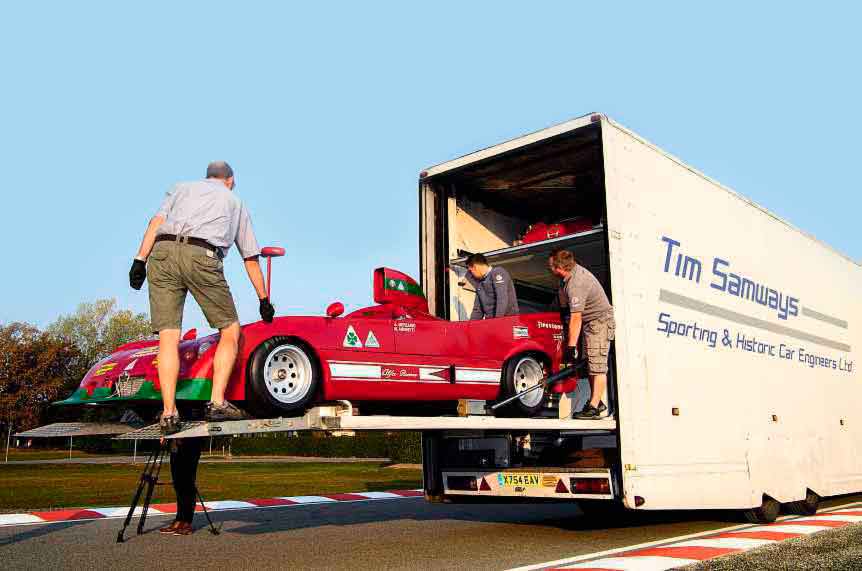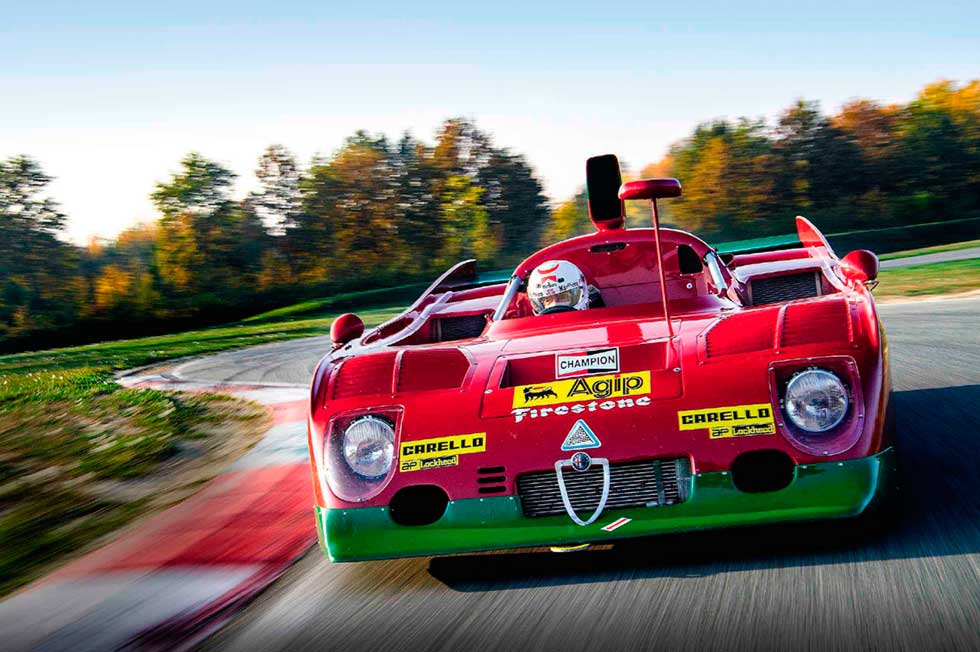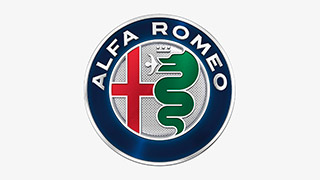
Noise and good company. On track in the 12-cylinder champion. Drive-My joins racing legends Bell, Merzario and Galli with the screaming flat-12-powered 1975 championship-winning Alfa-Romeo Tipo 33. Words Sam Hancock Photography Tim Scott.
1974 Alfa-Romeo Tipo 33 Bell, Marzario and an Italian legend
When it’s at high revs the Alfa Romeo’s Tipo 33/ TT12’s flat-12 strikes up a resonance that’s as eye-watering as it is deafening. I’m in the pit garage at Balocco, the proving ground in Northern Italy that was formerly the private test track of the marque’s dedicated racing division, Autodelta. The TT12 being warmed-up before me was born and raised here by now-legendary racing drivers, three of whom are present today. Here with me are Derek Bell, Arturo Merzario and Nanni Galli, at this most fitting of venues.

‘My heart skipped a beat arriving here this morning, so many memories flooding back,’ says a misty-eyed Merzario, somehow looking cooler than ever in the white cowboy hat that seems never to have left his head in 40-plus years. ‘This was like a home for us in the 1970s. We spent many months here, driving these cars every day; developing, preparing for races. We used to sleep over there, above the workshop!’ he says, pointing towards the barn that once formed Autodelta’s trackside facility.
Alfa Romeo is one of the oldest, most successful manufacturers in motorsport history, and the Tipo 33 era of the late 1960s and early 1970s is, to many, the most evocative of all. But its grand crescendo with the TT12 nearly didn’t happen at all. The man to thank is engineering genius Carlo Chiti. Back at Alfa Romeo after a World Championship-winning stint with Ferrari, Chiti’s Autodelta engineering firm had been absorbed by the Milanese marque in 1964.
‘There is not a hint of recalcitrance from the flat-12. The higher it revs, the more at ease it sounds’
Soon after, he was instructed to build a 2.0-litre sports car that would herald Alfa Romeo’s return to world class motorsport. The first Tipo 33 of 1967 was revealed in Balocco to an astonished press gathering, who marvelled at its beauty and remarkably low driving position. A debut win was followed in 1968 with class wins at Daytona, Le Mans and the Targa Florio before the model was completely reinvented for 1969 with an all-new 3.0-litre V8 and open monocoque chassis. This Tipo 33/3 allowed Alfa to challenge Porsche and Ferrari with their respective 908 and 312P. After a sticky start, notable class wins followed, albeit often in the shadow of the bigger 5.0-litre cars that fought for outright victory in the World Championship for Makes – or FIA World Sportscar Championship as it was more commonly known.

By 1973, rule changes capped engine capacities at 3.0 litres and Chiti, who had long hinted at the prospect of a 12-cylinder engine, sensed a chance for overall victory. Yet he delayed its debut to such an extent that it developed near-mythical status, finally appearing at Spa halfway through the ’73 season. The world at last was treated to the arresting, Ferrari-like howl of a flat-12, now bolted to an all new tubular chassis – or Tubolare Telaio (TT).
It was an inauspicious debut: Andrea De Adamich was pitched into the Stavelot barriers at immense speed when a tyre delaminated. Further outings proved equally challenging and, while the car clearly showed potential, it needed development. Shrewdly swerving the rigours of Le Mans, Chiti left rivals Ferrari, Matra and Mirage to duke it out for the Championship and set his sights on the following season.
‘I fear the pendulum effect in Balocco’s most notorious corner: Derek Bell says it makes Eau Rouge feel like a walk in the park’
And 1974 should have belonged to Alfa Romeo. Ferrari chose not to participate and the TT12’s wrinkles had largely been ironed out. But, being a nationalised company, Alfa Romeo was not immune to the prevailing winds of political forces and the global oil crisis made motor racing deeply unfashionable. After some success against a dwindling field, including a win for this very car at Monza in the hands of Merzario and Andretti, Alfa’s president announced in the August that it would withdraw from the remaining races. He also cast serious doubt on future participation, citing the poor health of the Italian motor industry and dwindling car sales.

Enter German team owner and racing driver Willi Kauhsen. A regular competitor in the German Interserie sports car races, Kauhsen had funding from a German sausage manufacturer and wanted to take over the programme for the 1975 season. Chiti, desperate to fight for a world title, engineered an opportunity to keep the Alfa Romeo programme alive under somebody else’s dime. Was Kauhsen a new sponsor? A new team manager? A new owner? In reality, it didn’t matter because Chiti had few intentions to change anything at all. The cars would remain factory red, deferring only to the new arrangement with the addition of WKRT (Willi Kauhsen Racing Team) emblazoned boldly on the nose.
Accounts conflict about whether Kauhsen’s more efficient German technicians turned things around, or whether they were window-dressing to keep the illusion alive that this was no longer an Italian-funded effort. German or Italian, Kauhsen or Chiti, something clicked and outright victories soon rolled in.
Drivers such as Bell, Pescarolo, Merzario, Ickx, Scheckter, Lafitte, Andretti and Mass contributed to seven wins out of eight races and finally secured Alfa Romeo the World Championship title. There wasn’t a drivers’ title that year, but Bell rightly contests that had there been, he would have won it: ‘I won four WCM races for Alfa, and I won Le Mans in the Mirage.’ He also recalls: ‘Kauhsen’s involvement that season was critical, and is too often overlooked. He helped us find reliability, and that was our key strength over the turbo-powered Renault Alpines. Chiti was a good man, but I had little to do with him.’
The powerful, rotund Chiti’s Achilles’ heel was perhaps that he was too caring. ‘He was a great man, a great engineer,’ recalls Arturo Merzario over another Coke. ‘But he couldn’t delegate. So many races we lost to overheating brakes, and when the TT12 was launched – an all-new design – still we had overheating brakes!’ I hope not to discover this for myself.
With the needles rising on the temperature gauges, preparer Tim Samways leans into the TT12’s engine bay and confidently blips the throttle harder. There is not a hint of recalcitrance from the 3.0-litre flat-12. The higher it revs, the more at ease it sounds. The deliciously awkward gargles on tickover give way to a rapid, shattering chorus that follows Samways’ every hand movement with freakish urgency.
This is chassis 008. To call it precious would be a gross understatement. In addition to that Monza win in ’1974, it claimed five of the seven victories that earned the World Championship title in 1975. Despite the revolving door of racing royalty at Autodelta, Merzario was at the wheel for every one. With oil and water suitably warmed, a nod is enough to tell me that I’m up – first. My job? A dozen laps or so to assess the car and put some heat into the wide, slick tyres and steel disc brakes before handing over to the three legends. The irony is not lost on me. These guys could do it with their eyes closed and I’m a little embarrassed at the prospect of readying a car for them. But it’s a mark of their graciousness that they clearly wouldn’t have it any other way. ‘Vai, vai Sam!’ shouts Merzario, ushering me into the car. ‘Anyway, I am telling Derek a story…’ he says with a mischievous grin that implies something to do with the fairer sex.
There’s enough legroom – just – for my lanky proportions. Only the low-hanging dashboard prevents me slinking deeper into my preferred knees-high, head-low driving position, so I sit a little upright, get strapped tight and await the signal to go.
Grabbing first gear with the wood-topped gearlever mounted to my right, I’m surprised at the extensive amount of travel across the gate. The clutch, however, is light and I pull away with ease. Riding into the throttle for the first time and already the sheer volume of the induction noise is astonishing, courtesy of the air intake towering by my left ear. An aural triumph but, my goodness, it’s thunderously loud.
‘Around 500 horsepower,’ Arturo had told me, ‘and it’s all at the top.’ He’s right. There is absolutely nothing below 8000rpm and it doesn’t even come on cam until nine. ‘Keep it around ten if you can,’ Samways had told me, ‘and shift at eleven!’
With a near-2km straight unfurling ahead of me, I let the stabled thoroughbred bolt. Up through third, fourth and briefly into fifth gear, it feels bizarre to hang on so long before upshifting. I’m positive there has been a misunderstanding and that surely this isn’t sustainable, but no, the revcounter is redlined at 11,200rpm, so I continue as instructed. Sure enough, the motor responds beautifully, each change of ratio dropping it perfectly back into the start of its narrow but impressive power band.
The soundtrack is absurd. Rapturous, orchestral, ear-splittingly loud. I feel utterly enveloped by noise and for a moment – while flat in top – I’m almost paralysed by it. This car was capable of 330km/h in period and there’s no reason it still isn’t. My sudden arrival, therefore, at a tight left-right chicane catches me by surprise and, while I shed speed sufficiently, it’s not so easy to get down the necessary three gears.
Fumbling a little with the unexpectedly long throw on the lever, I roll into the apex a cog too high and am met with obstinacy under my right foot through the exit. On the upside, the chassis navigates the twists with aplomb, the front feeling utterly glued, and the rear following suit. Similar turns follow and I sense the chassis twist and flex accommodatingly through the sharp direction-changes. A little squat at the rear on power, a little roll at the front on turn-in. It’s a delicious low-speed balance, with kartlike responses. No wonder the TT12 also won the Targa Florio in 1975.
But what about fast corners? They are no place for a twisting chassis and, although it’s only 670kg in mass, most of that is the engine and I fear the pendulum effect as I enter Balocco’s notorious Indianapolis-style corner: a long left that seems never ending. Derek Bell says it makes Spa’s Eau Rouge ‘like a walk in the park’. Merzario recalls that, while testing here in period, ‘this was the one corner you could not even think about making the slightest mistake – it could kill you’.
Mild banking gives it that American oval feel and, boy, does it make it fast. ‘We used to enter at 270km/h and emerge at 280km/h,’ relishes the diminutive Italian. ‘You could not afford to be even 10cm off line. But don’t worry, at least you have guardrails today. Back then we only had pine trees.’
I’ve no intention of risking a car that contributed so much to that 1975 world title, so I breathe on the brakes through the entry, happy to take things well below the limit and accelerate back up towards it later in the turn. Attempts over the first few laps are compromised by imperfect lines and, frankly, being somewhat daunted by the immensity of the curve. But a little later I find a line that works and lean confidently into the throttle pedal through the endless mid-corner.
Having felt little or no downforce over the rest of the lap, I am shocked to find it in abundance now. The sense of sure-footedness encourages me to add more throttle still and, for a moment, the car feels rock-solid. But all the while the forces are mounting and an uneasiness descends. I become keenly aware of the weight of the car and the immense strain on every component. Inevitably something has to give and I notice tiny variations in steering response that hint at the twisting chassis problem so vehemently complained about by period test driver, Teodoro Zeccoli. A deft touch is required and I understand why Derek Bell later joked that he thanked the car each time he emerged from this corner unscathed.
Saving my enthusiasms for less treacherous terrain, I focus on perfecting my gearshifts in order to attack the rest of the lap. Jacques Lafitte recently recalled that ‘the gearbox was not so easy’, and he wasn’t wrong. Unlike the 33/3, which has a succinct, pin-sharp gearchange, the TT12’s linkage is more complex, which reduces feel and precision. The narrow powerband doesn’t help either and, while I would normally leave downshifting until late in the braking zone to minimise the strain on the engine, the TT12 prefers the opposite: shift early to keep the revs high for a nice response when rolling into the throttle for a heel-toe ‘blip’.
‘Don’t nurse it, either,’ Samways had told me. ‘Be decisive.’ It works and pretty soon I’m feeling right at home.
I don’t have enough laps to generate the brake fade that so infuriated Merzario 40-odd years ago, but I settle in enough to fully understand why, and how, this most gorgeous sports racing car became the automotive treasure that it is today.
Exciting yet dangerous. Heavy yet nimble. Powerful yet initially unreliable. The TT12 is a mirror of the very environment in which it was created. Remarkably basic in so many ways, unfathomably complicated in others – with sparks of genius throughout. Could any racing car be more quintessentially Italian?
As the warm sun sets on our day, I’m left mesmerised. Not so much by the chassis, or the handling, or the brakes. Not even by the power, which is compromised by weight and rev range. But by this car’s aura. It draws transfixed bystanders towards it even when stationary. It raises every hair on my neck at the press of the starter button. It leaves onlookers open-mouthed as it howls past the pits on full song. It is, quite simply, one of the greatest sounds in motorsport.
Thanks To the car’s owner, Balocco proving ground, Tim Samways Sporting & Historic Cars.
Tech and photos
TECHNICAL DATA FILE SPECIFICATIONS 1974 Alfa Romeo Tipo 33/TT12
Engine 2995cc flat-12, DOHC per bank, Lucas mechanical fuel injection
Max Power 500bhp @ 11,000rpm (est DIN nett metric)
Max Torque 289 lb ft @ 6800rpm (est DIN nett metric)
Transmission Five-speed manual, rear-wheel drive
Steering Rack and pinion
Suspension Front and rear: double wishbones, coil springs, telescopic dampers
Brakes Discs
Weight 670kg
Top speed 206mph (approx)
0-62 MPH 3,9 seconds
‘The Tipo 33 of the late 1960s and early 1970s is, to many, the most evocative racer of all’
Right, far right and bottom right Race-prep specialist Tim Samways and co unload the Tipo 33 as the three legends get ready for the track; Arturo Merzario won the 1975 Targa Florio in a Tipo 33. Left and below Right-hand gearshift features wooden knob and exposed linkage; adjustable drilled pedals feature in ultra-sparse cockpit.
Clockwise from right (Left to right) Galli, Merzario and Bell; Merzario and Ralf Stommelen battle paired TT12s in the 1974 Nürburgring 1000km; writer Hancock chills post-drive; that flat-12.








